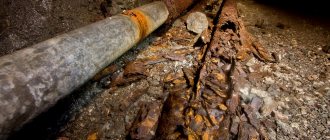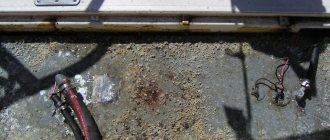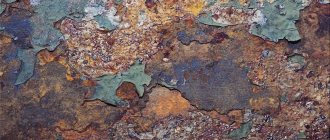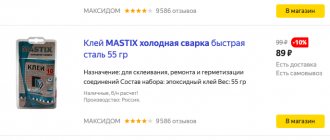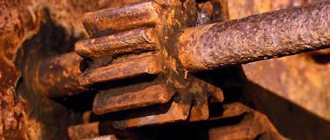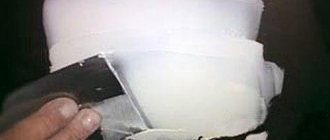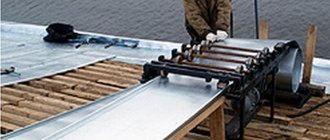Types of corrosion
To successfully combat corrosion, you need to know what types it is:
- Atmospheric. The oxidation process begins as a result of contact of the metal with oxygen and water vapor contained in the air. The speed of this process also depends on the chemically active substances contained in the air.
- Liquid. Found on metal products immersed in water. If the water contains salt, especially sea salt, the oxidation process accelerates.
- Soil. Appears on metal objects located in the ground. Soil is an aggressive, corrosive environment, which contains a large number of elements. Aggressiveness is determined by soil composition, pH, humidity, and electrical conductivity.
When choosing a method of corrosion protection, it is necessary to take into account the environment in which the metal structure is located.
Causes of rust formation on cast iron
Despite the fact that cast iron products are characterized by increased strength, they belong to the category of ferrous metals that are most prone to rust.
Due to the oxidation of metal, which occurs as a result of the interaction of oxygen with water, as well as when using chemicals, rust is formed.
Carbon steel is the most susceptible to rust.
The main causes of corrosion on cast iron:
- Poor quality material. To reduce the cost of manufacturing from cast iron, some enterprises sin by using cheap materials and various impurities to reduce the amount of pure metal.
- Wrong care. Rust can appear if you do not wipe off moisture from a washed cast iron frying pan, as well as in unheated rooms with high air humidity. Rusty spots also form if hot cast iron is washed with cold water.
- Rarely used in everyday life. If cast iron is not used for a long time, the likelihood of rust formation increases.
- Lack of oil coating on the surface. Before the first use, as well as in the future, it is recommended to lubricate the surface with vegetable oil, which protects the utensils from rusting.
Typical types of rust damage
The following types of destruction are distinguished:
- the surface is completely or partially covered with rust;
- small spots of rust are visible, which penetrate pointwise into the object;
- destruction in the form of a deep crack;
- destruction of one of the metals in the alloy occurs;
- deep penetration is observed over the entire surface;
- a combination of several techniques is possible.
According to the method of interaction of the metal with the external environment, chemical corrosion and electrochemical corrosion are distinguished. In the first case, rust is not associated with exposure to electric current, but in the second, the interaction of the metal surface with the electrolyte occurs.
Types and methods of applying protective coatings.
Protective coatings are classified into groups: inorganic and organic. The first includes metals (zinc, cadmium, aluminum, nickel, copper, chromium, silver, etc.) and their alloys (for example, bronze or brass), inorganic oxide and salt films. The second includes coatings based on varnishes, paints, enamels, polymers, plastics, and rubber.
There are different methods of anti-corrosion technology of protective coatings.
- Hot method. The process involves dipping the product into a container with liquid metal having a melting point lower than that of the metal being coated (galvanizing, tinning, aluminizing, lead plating).
- Galvanization (electrolytic method). A protective metal or alloy is deposited on the surface to be treated when current is passed through an electrolyte in the form of aqueous solutions of their salts (galvanizing, cadmium plating, nickel plating, chromium plating).
- Cladding (thermomechanical method). In this method, plates of protective material are applied to the surface of the metal to be protected and then subjected to hot rolling, obtaining a strong connection of several layers.
- Diffusion treatment method (alitizing, chrome plating, silicon plating).
- Metallization. A molten protective coating is sprayed onto the base metal using an air jet. Protecting metal from corrosion using metallization methods is one of the most reliable ways to prevent steel corrosion. The protective properties of zinc, aluminum or their alloys guarantee anti-corrosion protection for at least 20 years. Electric arc metallization can be carried out both in stationary production conditions (in a workshop), and after installation or during the repair of metal structures.
In world practice today, mainly more technological processes of spraying a protective layer of metals predominate, for example, high-speed, plasma (using argon, nitrogen, helium), detonation and flame spraying, as well as electric arc metallization and surfacing.
There are many other ways to process products, after which they become more resistant to corrosion and acquire an attractive appearance. Such methods include oxidation, anodizing, and bluing.
For many products, an attractive appearance is important, which can be achieved by applying decorative and protective coatings - nickel plating, chrome plating, silver plating, and gilding. For example, on a brass product, by passivation you can obtain a protective film that imitates gold plating.
Metals and non-metallic protective coatings provide an aesthetic appearance and effective protection from the negative effects of moisture. The simplest and most accessible method of combating corrosion is to coat metal structures with paints and varnishes, and many of them can be applied directly “to the rust” without first cleaning the surface.
Not long ago, ceramic coating technology using hybrid epoxy esters and micro-zinc particles with the addition of microspherical ceramics appeared on the Russian market.
Methods of protection against corrosion
Industrial
Industrial methods of protecting metal structures from rust include:
- Heat treatment.
- Paintwork. In this case, the coating must be continuous, gas and waterproof, have mechanical strength, hardness, and be elastic.
- Alloying of metals. One of the most effective ways. The alloying process involves adding alloying elements to the alloy composition. This contributes to the passivation of the metal, that is, the alloy becomes resistant to rust formation.
- Using another metal to protect the surface. A thin layer of metal (Al, Zn, Co) is applied using special equipment at a certain temperature and pressure.
- Electrical protection. Near the metal part, plates made of another metal element or alloy (anodes) are installed. The current flow in the electrolyte passes through these plates, and not through the product. This method is often used to protect underwater parts of marine transport and drilling platforms.
- Use of inhibitors. These are special substances that can stop a chemical reaction.
This is not the entire list of possible ways to protect against rust. Much depends on the environment in which the metal structure will be located.
Household
Household methods mainly come down to applying paint and varnish coatings. You can use:
- different polymers;
- metal powder;
- silicone resin;
- inhibitors.
Separately, it is worth mentioning the compositions that are applied to areas affected by corrosion. Converters allow you to restore metal from oxides and prevent further chemical reactions.
The following groups of converters are distinguished:
- Stabilizers, with the help of which iron oxides are converted into other substances.
- Converters of iron oxides to salts. After application, a protective barrier is formed by converting corrosion products.
- Primers with high adhesion. They cover the already protected surface. Thanks to the primer, you can save on finishing paint, since the composition contains inhibitory substances.
- Resins and oils have a neutralizing effect on rust particles by enveloping them.
Metal corrosion and methods of protection against it
How to protect metal? There are many corrosion methods for metals and ways to protect against it. To protect metal from rust, industrial methods are used. In everyday life, various silicone enamels, varnishes, paints, and polymer materials are used.
Industrial
Protection of iron from corrosion can be divided into several main areas. Methods of protection against corrosion:
- Passivation. When producing steel, other metals are added (chromium, nickel, molybdenum, niobium and others). They are distinguished by increased quality characteristics, refractoriness, resistance to aggressive environments, etc. As a result, an oxide film is formed. These types of steel are called alloyed.
- Surface coating with other metals. Various methods are used to protect metals from corrosion: electroplating, immersion in a molten composition, application to the surface using special equipment. As a result, a metal protective film is formed. Chromium, nickel, cobalt, aluminum and others are most often used for these purposes. Alloys (bronze, brass) are also used.
- The use of metal anodes, protectors, often made of magnesium alloys, zinc or aluminum. As a result of contact with the electrolyte (water), an electrochemical reaction begins. The protector breaks down and forms a protective film on the surface of the steel. This technique has proven itself well for underwater parts of ships and offshore drilling rigs.
- Acid etching inhibitors. The use of substances that reduce the level of environmental impact on metal. They are used for preservation and storage of products. And also in the oil refining industry.
- Corrosion and protection of metals, bimetals (cladding). This is coating steel with a layer of another metal or a composite composition. Under the influence of pressure and high temperatures, diffusion and bonding of surfaces occurs. For example, well-known heating radiators made of bimetal.
Metal corrosion and methods of protection against it used in industrial production are quite diverse, such as chemical protection, glass enamel coating, and enameled products. Steel is hardened at high temperatures, over 1000 degrees.
On video: galvanizing metal as protection against corrosion.
Household
Protecting metals from corrosion at home is, first of all, chemicals for the production of paints and varnishes. The protective properties of the compositions are achieved by combining various components: silicone resins, polymer materials, inhibitors, metal powder and shavings.
To protect the surface from rust, it is necessary to use special primers or a rust converter before painting, especially old structures.
What types of converters are there:
- Primers - provide adhesion, adhesion to metal, level the surface before painting. Most of them contain inhibitors that significantly slow down the corrosion process. Preliminary application of a primer layer can significantly save paint.
- Chemical compounds - convert iron oxide into other compounds. They are not subject to rust. They are called stabilizers.
- Compounds that convert rust into salts.
- Resins and oils that bind and seal rust, thereby neutralizing it.
These products contain components that slow down the process of rust formation as much as possible. Converters are included in the product line of manufacturers producing metal paints. They vary in consistency.
It is better to choose primer and paint from the same company so that they match the chemical composition. You must first decide which methods you will choose to apply the composition.
Methods for increasing resistance
Corrosion resistance can be achieved by adding special elements (stainless steels). Such additives are nickel, manganese, chromium, copper, cobalt in a certain dosage.
The process of metal rusting can also be prevented by removing from its composition components that accelerate the destructive process (oxygen and sulfur from steel alloys, iron from aluminum and magnesium alloys).
Reduction of environmental aggressiveness and electrochemical protection
By adding inhibitors to the external environment, the oxidation process can be stopped. They allow chemical reactions to slow down hundreds of times.
The electrochemical potential of steel changes under the influence of electric current. This process allows you to slow down or stop the rusting process.
